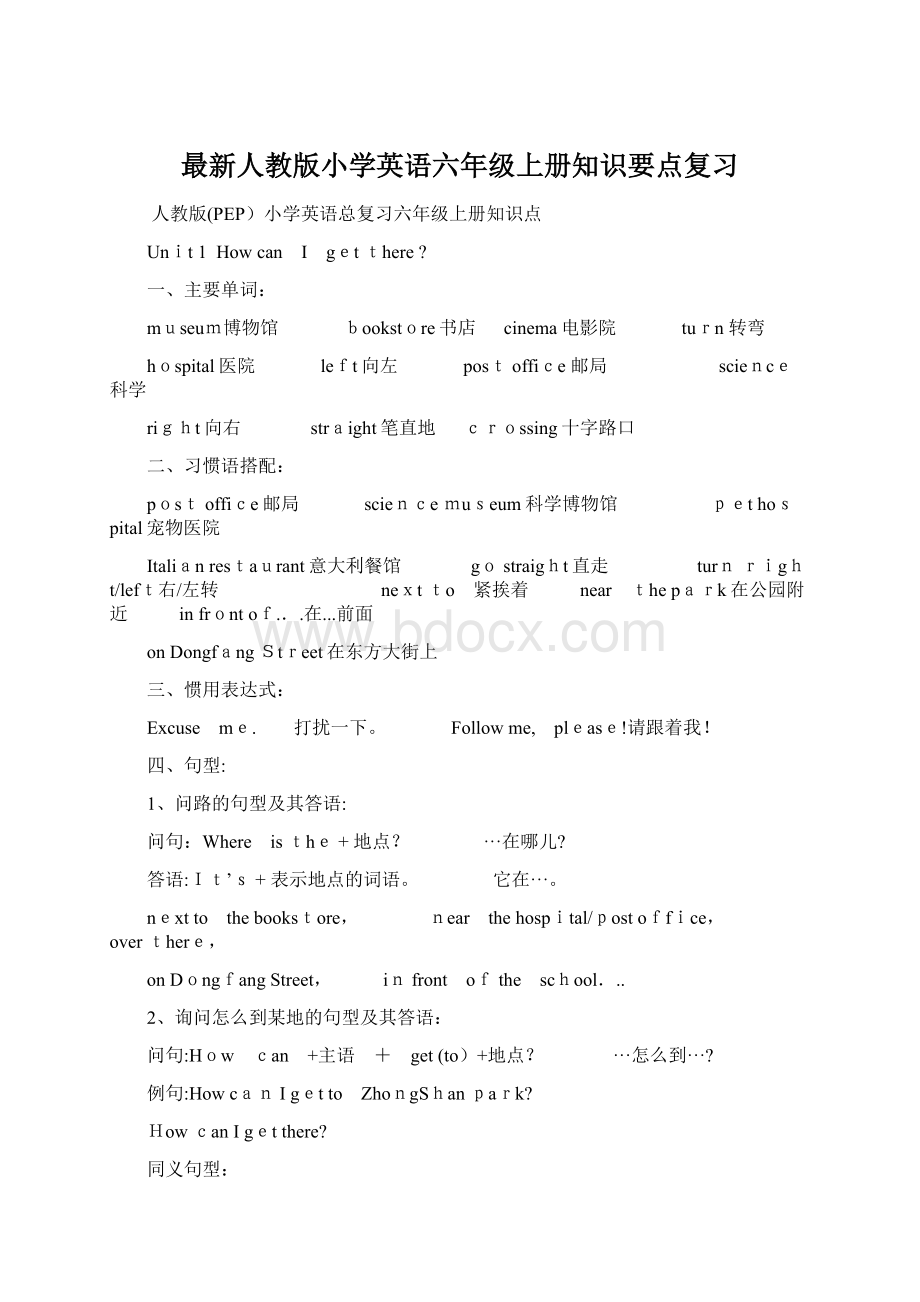最新人教版小学英语六年级上册知识要点复习.docx
《最新人教版小学英语六年级上册知识要点复习.docx》由会员分享,可在线阅读,更多相关《最新人教版小学英语六年级上册知识要点复习.docx(12页珍藏版)》请在冰豆网上搜索。

最新人教版小学英语六年级上册知识要点复习
人教版(PEP)小学英语总复习六年级上册知识点
Unit 1 How can I getthere?
一、主要单词:
museum博物馆 bookstore书店 cinema电影院 turn转弯
hospital医院 left向左 postoffice邮局 science科学
right向右 straight笔直地 crossing十字路口
二、习惯语搭配:
postoffice邮局 sciencemuseum科学博物馆 pethospital宠物医院
Italianrestaurant意大利餐馆 gostraight直走 turnright/left右/左转 nextto 紧挨着 near thepark在公园附近 infrontof...在...前面
onDongfangStreet在东方大街上
三、惯用表达式:
Excuse me. 打扰一下。
Followme, please!
请跟着我!
四、句型:
1、问路的句型及其答语:
问句:
Where isthe+地点?
···在哪儿?
答语:
It’s+表示地点的词语。
它在···。
nextto thebookstore, near thehospital/postoffice, overthere,
onDongfangStreet, infront ofthe school...
2、询问怎么到某地的句型及其答语:
问句:
How can +主语 + get(to)+地点?
···怎么到···?
例句:
HowcanIgetto ZhongShanpark?
HowcanIgetthere?
同义句型:
Canyoutellmethewayto +地点?
Whereis +地点?
Whichisthe wayto+地点?
答语:
Turn +方向(left/right)+表示地点的介词短语。
···转。
atthecinema atthecornernearthepost office...
五、例句:
Where is the museum shop?
博物馆在哪里?
It’s near the door. 在大门附近。
Howcanwegetthere?
我们怎么到那儿?
Turn left at the bookstore。
到书店左转。
六、主题写作:
范文
HowtoGettotheScienceMuseum
Wearegoingtothe sciencemuseumtomorrow.Thesciencemuseum is nexttothehospital.It’snotfar fromourschool.So wecangothereonfoot.First,go straightfromourschool.Next,turnleftatthe postofficeandwalkforaboutfiveminutes.Thenturn rightatthe bookstore.We canfindthe hospitalontheright.Walk straight,andwe’ll seethescience museum.
Unit2 Waysto gotoschool
一、主要单词:
by乘bus公共汽车 onfoot步行 plane飞机
taxi出租车 ship(大)船 subway地铁 train火车
slow慢的 stop停下 always 总是,一直 usually 通常
often经常 sometimes 有时候 never 从来不
二、习惯语搭配:
bybike/bus/plane/subway/train/ship/taxi/ferry/boat
骑自行车/乘公共汽车/飞机/地铁/火车/船/出租汽车/渡轮/小船
taketheNo.57bus乘57路公共汽车 onfoot步行slowdown慢下来 payattentionto注意 trafficlights 交通信号灯 athome在家
get to到达 be far from…表示离某地远
三、惯用表达式:
Go at a green light. 绿灯行。
Slowdownandstopatayellowlight.在黄灯的时候慢下来并停止。
Stop and waitat a red light.在红灯的时候停下来并等一等。
四、句型:
1、如何询问对方的出行方式:
Howdoyoucome(to)+地点?
你(们)怎么来···的?
Usually Igotoschool on foot.我通常步行去学校。
(同义句)=UsuallyIwalk toschool.
2、用must、haveto表示必须做某事:
某人+must+动词原形(+其它). ···必须···。
You mustwashyourclothes.你必须洗你自己的衣服。
(同义句)You havetowashyour clothes.
3、告诫别人不要做某事的句型:
Don’t +动词原形(+其它). .不要/别···
例句:
Don’t goattheredlight.不要闯红灯。
五、例句:
How do you come to school?
你怎么来上学?
Usually I come on foot. 通常我步行去上学。
In the USApeopleon bikesmustwear the helmet. 在美国骑自行车的人们都必须戴头盔。
Don’tgoat theredlight. 别闯红灯。
Imust payattentiontothetrafficlights.我必须注意交通信号灯。
Unit3Myweekendplan
一、主要单词:
tomorrow明天 film电影 supermarket超市 trip旅行 tonight在今晚=thisevening evening晚上/傍晚nextweek下周 comic连环画 dictionary词典 word单词 postcard明信片 visit拜访
二、习惯搭配:
take atrip去旅行 gofora picnic去野餐 goto thecinema去看电影 visit mygrandparents看望我(外)祖父母 get together聚会gotothe supermarket去超市 goice-skating去滑冰 make asnowman堆雪人 seeafilm看电影 makemooncakes做月饼 readapoem朗诵一首诗 thisweekend这周末 tellastory/ tellstories讲故事nextweek下周 thismorning/afternoon/evening今天上午/下午/晚上 nextWednesday下星期三
三、惯用表达式:
What aboutyou?
你呢?
Herethey are!
它们在这儿!
CanI helpyou?
我能帮助你吗?
Soundsgreat!
听起来很棒!
Haveagoodtime!
玩得开心!
四、句型:
1、询问对方打算做什么的句型及其答语:
问句:
Whatare you going todo+其它?
你/你们···打算做什么?
nextweek tonight tomorrow thismorning/afternoon/eveningthisweekend...
答语:
I’m/We’re going to+动词(短语)原形+其它. 我/我们打算···。
be(am,is,are)going to+动词原形=will +动词原形
seea film takeatrip visitmy grandparents watchTV...
2、询问对方打算去哪儿的句型及答语:
问句:
Whereareyougoing(+将来时间)?
你/你们打算(···)去哪儿?
答语:
I’m/We’regoing (tothe)+地点. 我/我们打算去···。
3、询问对方打算何时去做某事的句型及答语:
问句:
Whenareyougoingto+动词(短语)原形?
你/你们打算什么时候···?
答语:
I’m/We’regoingto+动词(短语)原形+将来时间.我/我们打算···。
五、例句:
What are you going to do tomorrow?
你明天打算做什么?
I’m going to haveanartlesson. 我要上美术课。
=I willhaveanartlesson.
Where are you going this afternoon?
你今天下午打算去哪里?
I’m going to the bookstore. 我打算去书店。
What are you going to buy?
你打算去买什么?
I’m going to buy a comic book. 我打算去买一本漫画书。
= Iwillbuy acomic book.
Unit4 Ihaveapenpal
一、主要单词:
studies学习(第三人称单数形式) puzzle谜 hiking远足
二、习惯搭配:
readstories读故事 do kungfu练功夫 fly kites放风筝 playthe pipa弹琵琶
playsports进行体育活动 climb mountains爬山 listentomusic听音乐
singEnglishsongs唱英文歌onafarm在一个农场里 live in...住在···
writeanemailto...给···写一封电子邮件ontheplayground在运动场上go hiking/swimming/fishing去远足/游泳/钓鱼
三、惯用表达式:
Metoo.我也是。
Really?
真的吗?
四、句型:
1、询问某人爱好的句型及其答语:
问句:
Whataresb.’s hobbies?
···有什么爱好?
答语:
主语+like/likes+动词-ing形式(+其它). ···喜欢···。
Singing dancing readingstories playingfootball doing kungfudoing word puzzles goinghikingwatchingTV drawingcartoons listeningtomusicgoingfishing
2、由do/does引导的一般疑问句及其答语:
问句:
Do/Does+主语+动词原形+其它?
答语:
Yes,主语+do/does./No,主语+don’t/doesn’t.
五、语法:
1、动词变为动名词的规则:
动词变为动名词,即是动词加ing。
一般要遵循以下三条规则:
(1)一般情况下,在动词的后面直接加ing。
如:
play—playing read—reading do—doing go—going
(2)以不发音的字母e结尾的动词,要去掉不发音的字母e,再加ing。
如:
write—writing ride—riding make—making dance—dancing
(3)以单元音加单辅音结尾的重读闭音节,要双写最后一个辅音字母,再加ing。
如:
run—running swim—swimming put—putting sit—sitting
2、关于第三人称单数:
动词变为第三人称单数形式的规则:
(1)在一个句子中,如果主语人称既不是你,也不是我,而是另外的一个人,这时的人称叫做第三人称单数。
(2)在第三人称单词的句子中,动词要使用第三人称单词形式。
(3)动词变为第三人称单数形式,要遵循以下规则:
①一般情况下,在动词的后面直接加s。
如:
read--reads make—makes write—writes
②以字母s, x, o , sh , ch结尾的动词,在词尾加es。
如:
do—does wash—washes teach—teaches go—goes pass—passes
③以y结尾的动词分为两个情况,以元音字母加y结尾的动词,在词尾直接加s。
如:
play—plays buy--buys
以辅音字母加y结尾的动词,要把y变为i,再加es.如:
study--studies
④以f , fe结尾的名词,先把f,fe变为v,再加-es.
⑤特殊变化:
have--has
(4)在一个第三人称单数的句子中,只要句子中出现了does或者其否定形式doesn’t.该句子中的其他动词就要使用原形。
(5)第三人称单数的肯定句在变为否定句时,在动词的前面加doesn’t. 动词恢复原形。
如:
He lives in Beijing.---He doesn’t live in Beijing.
(6) 第三人称单数的陈述句在变为一般疑问句时,用does开头,后面的动词也要变为原形。
如:
He lives in Beijing.---Does he live in Beijing?
3、注意几个单词的变化:
hobby(复数形式)—hobbies have to(同义词)—must
六、反义词或对应词:
near(近的)—far(远的) fast(快的)—slow(慢的) same(相同的)—different(不同的) here(这里)---there(那里) left(左)---right(右)
七、主题写作:
范文
Li Ying’s Hobbies
Li Ying likes English verymuch.Sheworkshardatit.Shereads English everymorning.She likesspeaking English .Shelikes listeningtotheradio,too.Shewatches TV onlyon Saturday evening.
Doesshe likecooking Chinesefood?
No, she doesn’t.She likesdoingword puzzles.Shedoesn’tlike playingbasketball.Her parents loveher.All theteachersloveher,too.Shesays her hobbiesmakeherhappy.
Unit5What does he do?
一、重点单词:
factory工厂 postman邮递员 policeofficer警察 fisherman渔民 scientist科学家 pilot飞行员 coach教练 businessman商人;企业家 worker工人
二、习惯搭配:
bycar/bus/bike/plane/boat乘小汽车/公共汽车/自行车/飞机/船
gotowork去上班studyhard努力学习stayhealthy保持健康gohome回家 lots of许多 gotothe camp去度假营 begoodat...擅长···
三、惯用表达式:
Cool!
酷!
Whatabout you?
你呢?
That’snice.那真好。
Isee.我明白了。
四、公式化句型:
1、询问他人的职业的句型及其答语;
问句:
Whatdoes+主语(第三人称单数)+do?
···是做什么的?
答语:
He/Sheis a/an+职业名称. 他/她是一位···。
worker postmanbusinessman fishermanscientistpilotcoach
policeofficer salesperson售货员cleaner清洁工 teacher dancer舞蹈演员
doctor nurse护士 pianist钢琴家 dentist牙医 tailor裁缝
2、询问他人的工作地点的句型及其答语:
问句:
Wheredoes+主语(第三人称单数)+work?
···在哪儿工作?
答语:
He/Sheworks+(表示地点的)介词短语. 他/她···工作。
at a university in a gym atsea on aboat atthezoo
inaschool ina bank在一家银行 inacarcompany在一家汽车公司
3、询问他人的上班方式的问句及其答语:
问句:
Howdoes+主语(第三人称单数)+goto work?
···怎么去上班?
答语:
He/She goestowork+交通方式. 他/她···去上班。
by bike/bus/subway/plane/train/ship/ferry/...onfoot
五、一些由动词变化而来的职业名词:
teach—teacher clean—cleaner sing—singer dance—dancer
drive—driver write—writer TV report—TV reporter act—actor
act—actress art—artist engine—engineer
六、主题写作:
范文
ILove My Family
Hereis aphoto ofmyfamily.Therearefour peopleinmy family.Theyare myfather,mymother,mybrotherandme.
My fatherisadoctor.Heworksin ahospital.Hegoes toworkbysubway.My motherisateacher.She worksin aschool nearmyhome.Shegoes toworkbybike.Look, thetallboyismybrother.Heisolderthanme.Heis a pilot.He’sinBeijingnow.Hegoesthere byplane.Iamastudentnow.
Ilove myfamily.
Unit6How doyoufeel?
一、主要单词:
angry生气的 afraid害怕 worried担心的;发愁的 happy高兴的
seeadoctor看病 more更多的 wear穿 deep深的
breath呼吸(名词)count数数(动词) sad难过的
二、习惯搭配:
feelangry/ill/happy/sad感觉生气/不舒服/高兴/难过 beafraidof...害怕···
be angry with...与···生气 takeadeepbreath深深吸一口气 count toten数到十 seeadoctor看病 do moreexercise做更多的运动
wear warmclothes穿暖和的衣服 chasethemice追赶老鼠
drink somedrinks喝一些饮料 havesomepopcorn吃一些爆米花
三、惯用表达式:
Hereyouare.给你。
Waitforme.等我一下。
Yum!
太美味了!
四、句型:
1、描述某人/某物害怕什么的句型:
主语+be动词+afraidof+其他. ···害怕···。
2、描述某人/某物与什么生气的句型:
主语+be动词+angrywith+其他. ···与···生气。
3、询问某人怎么了的句型及其答语:
问句:
What’swrong?
What’sthematter(withyou)?
怎么了?
答语:
某人+所处的状况。
4、建议某人应该做某事的句型
某人+should+动词(短语)原形+其他. ···应该···。
takeadeepbreath count totensee a doctor domoreexercisewearwarmclothes...
五、做“对句子划线部分提问”试题时,一般应该遵循三个步骤: